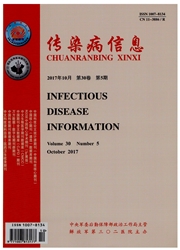

 中文摘要:
中文摘要:
目的分析临床分离的不同形式恩替卡韦(ETV)耐药HBV株的病毒复制力并探讨替诺福韦酯(TDF)对其的抑制力。方法从4例ETV治疗失败的慢性乙型肝炎患者血清中提取并扩增HBV反转录酶(reverse transcriptase,RT)基因,克隆测序分析其基因型耐药变异特点。选取代表性野生型和ETV耐药型HBV克隆株,构建pTriEx-HBV(C)1.1倍重组表达载体。提纯质粒转染HepG2细胞系,5d后检测上清中HBVDNA产生量,分析不同变异形式ETV耐药变异株体外复制力水平及TDF对其抑制力。结果 4份血清中共得到16种含不同HBVRT区变异形式的克隆株,10种与ETV耐药有关,另有6种与拉米夫定耐药有关。表型分析显示:与野生株相比,ETV耐药变异株复制力水平均有所下降,其中rtT184I+M204I变异株复制力最低,是野生株的19.3%,rtM204I+M250L基础上出现补偿突变(rtL80I、rtV173L和rtL180M)的变异株复制力较高,存在相同补偿突变的前提下,rtM204I基础上的耐药变异较rtM204V基础上的复制力低。TDF对各种类型ETV耐药变异病毒的复制力均有较强抑制作用(96.11%~99.90%)。结论与野生株相比,不同变异形式的ETV耐药变异株体外复制力均下降,TDF可有效抑制ETV耐药变异株复制,将是治疗ETV耐药患者的一种很好的选择。
 英文摘要:
英文摘要:
Objective To analyze the replicative competence of HBV isolates with different entecavir-resistant (ETV-r) patterns and to investigate the inhibitory efficacy of tenofovir disoproxil (TDF) in vitro. Methods HBV DNA was extracted from the sera of 4 ETV-refractory patients with chronic hepatitis B. The reverse transcriptase (RT) gene was amplified by nested PCR. Geno- typic ETV-r mutation was analyzed by clonal sequencing, pTriEx-HBV (C) 1.1 expression plasmids containing HBV wild-type and ETV-r mutants were constructed and transfeeted into HepG2 cells. The replieative competence of ETV-r mutants and the inhibitory efficacy of TDF were analyzed by measuring the HBV DNA production in supernatant after 5 days of transfection. Results HBV mutants harboring 16 different mutational patterns in the RT region were identified from the 4 samples. Among them, l0 patterns were associated with ETV resistance, and 6 patterns with lamivudine resistance. Phenotypic analysis showed that all ETV-r strains exhibited reduced replieative competence compared to wild-type strains in vitro, rtT184I+M204I strain showed the lowest replica- tive competence, only 19.3% that of wild-type strains, while the ETV-r mutants harboring complementary mutations(rtLSOI, rtV173L and rtL180M) to rtM204I+M250L showed the relatively higher replicative competence. ETV-r mutants with rtM204I showed a lower replicative competence compared to rtM204V in conjunction with the same complementary mutations. In vitro phenotypic analysis showed that TDF could effectively suppress the replication of ETV-r strains with the inhibitory ratio of 96.11%-99.90%. Conclusions Various ETV-r strains show a lower replicative competence compared to wild-type strains in vitro. TDF can effec- tively suppress the replication of ETV-r strains and will be an optimal choice for ETV-r patients in clinical practice.
 同期刊论文项目
同期刊论文项目
 同项目期刊论文
同项目期刊论文
 期刊信息
期刊信息
